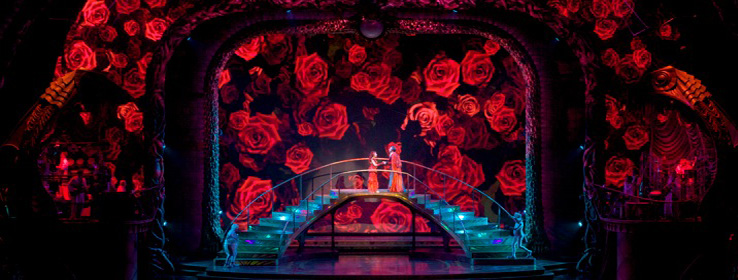A look at color's starring role in several Cirque du Soleil shows.
I'm a Cirque du Soleil groupie. If the trademark blue and gold Grand Chapiteau (aka big top) is coming to town, I'll be there. Cirque du Soleil combines jaw-dropping circus arts with outrageous costumes, sets and lighting. With permanent and touring shows around the world, the Quebec-based company creates enchanting worlds through acrobatics, visual effects, music and (most intriguing to me) color.
As they say on their website, Cirque strives to fall "on the dividing line between reality and fantasy, our creations are portals into unknown worlds." Every time I see a show, its dazzling color blows me away. And I've always been fascinated with the evolution of their distinctive color palettes. Each show is developed around a central, themed storyline. Every aspect of the performance is choreographed to support and enhance the overall message of the show. Nothing is arbitrary or extraneous: the narrative is woven throughout the artists' movements, musicians' music, even the beams of light shining down on the sets. Here's a look at the inspiration behind the color in several Cirque du Soleil shows.
Kooza
Cirque's show
Koozais an ode to more traditional circus arts, in a palette of red, white and gold. Costume designer Marie-Chantale Vaillancourt drew inspiration for the characters from such unlikely sources as graphic novels, comic books, the paintings of Gustav Klimt, and Indian and Eastern European art. Kooza is told from the point of view of a childlike, naive character called the Innocent, so many costumes conjure up images of children's toys and stories. Inspired by quick-change artists and magicians, some performers' costumes can even change color - morphing from gold to red in a split second.
Corteo
Corteo remains one of my favorite shows, a dreamlike world created with a gorgeous soft palette of pastel blue and pink, along with copper and gold hues. A visit to the exhibition "The Great Parade: Portrait of the Artist as Clown" at the National Gallery of Canada compelled set designer Jean Rabasse to design the watercolor painting "Corteo Procession" on enormous curtains spanning the stage.
So much goes into the development of any given aspect of a Cirque show. For example, more than 9,000 images were used in the research and development phase of the Corteo set design to enable the blending of many visual styles and influences, from the baroque to the modern. Costumes also took cues from European styles between 1890 and 1930, with an added layer of airbrushing and dye to create that worn, hand-me-down look. Each character's costume has its own unique style and color palette.
Zarkana
Zarkana is a new rock opera production for Cirque. Each musical number in Zarkana is assigned a distinct color palette. "In the lyrical, fantastic world of Zarkana, the setting, an abandoned decrepit theater, is a character in its own right," says Stéphane Roy, set and props designer. "The walls breathe, move and sing. In terms of aesthetics, we are at the beginning of the last century, between 1910 and 1930, midway between [Antoni] Gaudí, [Gustav] Klimt and Art Nouveau. The organic shapes are a nod to the master French glassmaker and jeweler René Lalique."
Costume designer Alan Hranitelj took similar inspiration from the 1920s, the '30s and the Art Deco movement for the overall visual aesthetic of the costumes. Capturing the golden age of Coney Island circus sideshows, Hranitelj also looked at various artists from that era, including Joan Miró and Russian-French designer Erté. With a wide overall spectrum of colors represented in the show, Hranitelj had the challenge of integrating the predominantly white palette of clown characters called "Movers" with the darker tones of the show. "It's a paradox, for sure, but it's also been stimulating and rewarding to come up with an approach that reconciles two such seemingly contradictory elements," Hranitelj says.
Color plays a starring role in Cirque du Soleil performances, whether through lighting, costumes, sets or all three. In fact, our suspension of disbelief begins with color — when we first enter the blue and gold tents of Cirque du Soleil, ready to become immersed in the colorful otherworld created for our entertainment and amazement.





